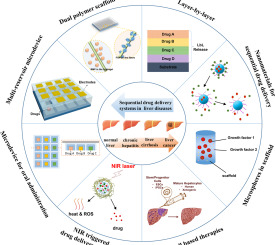Advanced Drug Delivery Reviews ( IF 15.2 ) Pub Date : 2019-11-15 , DOI: 10.1016/j.addr.2019.11.001 Xiaozhong Huang , Fan Lee , Yao Teng , Corey Bryen Lingam , Zijian Chen , Min Sun , Ziwei Song , Gowri M. Balachander , Hwa Liang Leo , Qiongyu Guo , Imran Shah , Hanry Yu

|
The liver performs critical physiological functions such as metabolism/detoxification and blood homeostasis/biliary excretion. A high degree of blood access means that a drug’s resident time in any cell is relatively short. This short drug exposure to cells requires local sequential delivery of multiple drugs for optimal efficacy, potency, and safety. The high metabolism and excretion of drugs also impose both technical challenges and opportunities to sequential drug delivery. This review provides an overview of the sequential events in liver regeneration and the related liver diseases. Using selected examples of liver cancer, hepatitis B viral infection, fatty liver diseases, and drug-induced liver injury, we highlight efforts made for the sequential delivery of small and macromolecular drugs through different biomaterials, cells, and microdevice-based delivery platforms that allow fast delivery kinetics and rapid drug switching. As this is a nascent area of development, we extrapolate and compare the results with other sequential drug delivery studies to suggest possible application in liver diseases, wherever appropriate.
中文翻译:

肝病的顺序给药
肝脏执行重要的生理功能,例如新陈代谢/排毒和血液稳态/胆汁排泄。高度血液通路意味着药物在任何细胞中的停留时间都相对较短。这种短时间暴露于细胞的药物需要局部顺序递送多种药物,以实现最佳功效,效力和安全性。药物的高新陈代谢和排泄也给顺序给药带来了技术挑战和机遇。这篇综述概述了肝脏再生和相关肝脏疾病中的顺序性事件。我们使用精选的肝癌,乙型肝炎病毒感染,脂肪肝疾病和药物引起的肝损伤的例子,重点介绍了通过不同生物材料,细胞,基于微设备的输送平台,可实现快速输送动力学和快速药物切换。由于这是一个新兴的领域,因此我们推论并将结果与其他连续药物递送研究相比较,以建议在适当情况下可能在肝病中的应用。


















































 京公网安备 11010802027423号
京公网安备 11010802027423号